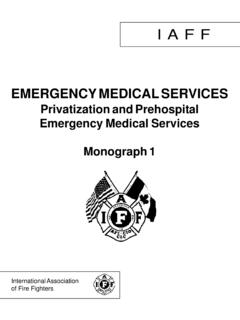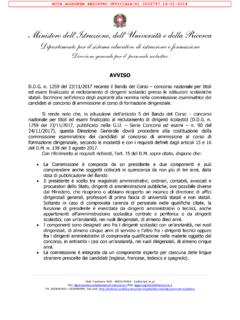Transcription of Emergency Vehicle and Roadway Scene Safety - IAFF Main
1 Emergency Vehicle andRoadway Scene SafetyEmergency Vehicle andRoadway Scene SafetyThe international association of fire FightersDivision of Occupational Health, Safety & Medicinein conjunction with Department of Homeland SecurityUnited States fire AdministrationThe international association of fire FightersDivision of Occupational Health, Safety & Medicinein conjunction with Department of Homeland SecurityUnited States fire AdministrationThis project was developed through a Cooperative Agreement (EME-2004-CA-0188) between the Department of Homeland Security,United States fire Administration and the international association of fire ObjectiveCourse ObjectiveAfter completing this course, the fire fighter should have a greater awareness of the issues affecting fire fighter Safety relative to riding on fire apparatus and operating at Roadway Emergency scenes. The fire fighter will also understand basic strategies for improving Safety during Vehicle and Roadway incident completing this course, the fire fighter should have a greater awareness of the issues affecting fire fighter Safety relative to riding on fire apparatus and operating at Roadway Emergency scenes.
2 The fire fighter will also understand basic strategies for improving Safety during Vehicle and Roadway incident ObjectiveIAFF ObjectiveThe IAFF believes that all of our members must have a greater awareness of the issues affecting fire fighter Safety relative to riding on fire apparatus and operating at Roadway Emergency scenes. Our members and local leadership must have basic strategies for improving Safety during Vehicle and Roadway incident IAFF believes that all of our members must have a greater awareness of the issues affecting fire fighter Safety relative to riding on fire apparatus and operating at Roadway Emergency scenes. Our members and local leadership must have basic strategies for improving Safety during Vehicle and Roadway incident 1: IntroductionSection 1: IntroductionAfter completing this section, the fire fighterwill be able to:1. Identify the approximate percentage of fire fighters whodie in Vehicle -related incidents each List the three primary areas that will be covered in this Discuss the cultural change that is needed by the fire service to reduce injuries and deaths and discuss some of the basic changes that are completing this section, the fire fighterwill be able to:1.
3 Identify the approximate percentage of fire fighters whodie in Vehicle -related incidents each List the three primary areas that will be covered in this Discuss the cultural change that is needed by the fire service to reduce injuries and deaths and discuss some of the basic changes that are Is This Program Needed?Why Is This Program Needed? 20% to 25% of fire fighter fatalities are Vehicle -related This is the 2ndleading cause of fire fighter deaths These are among the most preventable deaths 20% to 25% of fire fighter fatalities are Vehicle -related This is the 2ndleading cause of fire fighter deaths These are among the most preventable deathsUniversity of Michigan Study In 1998 University of Michigan Study In 1998 2,472fire apparatus collisions per year 6occupants of fire apparatus killed per year 413occupants of fire apparatus injured per year 21civilians killed by fire apparatus per year 642civilians injured by fire apparatus per year 2,472fire apparatus collisions per year 6occupants of fire apparatus killed per year 413occupants of fire apparatus injured per year 21civilians killed by fire apparatus per year 642civilians injured by fire apparatus per yearThe USFA Focuses On Vehicle and Roadway Scene SafetyThe USFA Focuses On Vehicle and Roadway Scene Safety Published the Emergency Vehicle Safety Initiativein 2004 Commissioned the IAFF and other organizations to study the issues more in depth Published the Emergency Vehicle Safety Initiativein 2004 Commissioned the IAFF and other organizations to study the issues more in depthThe IAFF Program s FocusThe IAFF Program s Focus1.
4 Apparatus occupant Safety procedures2. fire department response policies3. Roadway Scene Safety procedures1. Apparatus occupant Safety procedures2. fire department response policies3. Roadway Scene Safety proceduresFairfax Co., VA Local 2068 Fairfax Co., VA Local 2068A Cultural Cultural Injuries and deaths are not part of the business The only acceptable level of injury and death is zero Given the hazards we face, this is not realistic, but substantial improvements can be made Injuries and deaths are not part of the business The only acceptable level of injury and death is zero Given the hazards we face, this is not realistic, but substantial improvements can be madeWhat We Need To DoWhat We Need To Do fire departments and unions must develop and enforceapplicable SOPs Each fire fighter must take responsibility for their own actions We must watch out for each other and stop unsafe actions when we see them fire departments and unions must develop and enforceapplicable SOPs Each fire fighter must take responsibility for their own actions We must watch out for each other and stop unsafe actions when we see themSection 2: Apparatus Occupant SafetySection 2.
5 Apparatus Occupant SafetyAfter completing this section, the fire fighter will be able to:1. List the driver/operator s responsibilities towards ensuring apparatus occupant List the company officer s responsibilities towards ensuring apparatus occupant completing this section, the fire fighter will be able to:1. List the driver/operator s responsibilities towards ensuring apparatus occupant List the company officer s responsibilities towards ensuring apparatus occupant 2: Apparatus Occupant SafetySection 2: Apparatus Occupant Safety3. List the fire fighter s responsibilities towards ensuring apparatus occupant List the fire department s responsibilities towards ensuring apparatus occupant List the fire fighter s responsibilities towards ensuring apparatus occupant List the fire department s responsibilities towards ensuring apparatus occupant Study 1 Las Vegas (IAFF Local 1285)Case Study 1 Las Vegas (IAFF Local 1285) Engine 6 s resting location after rolling over on the exit ramp Engine 6 s resting location after rolling over on the exit rampCase Study 1 Las Vegas (IAFF Local 1285)Case Study 1 Las Vegas (IAFF Local 1285) Engine 6 s position relative to the concrete barrier Engine 6 s position relative to the concrete barrierCase Study 1 Las Vegas (IAFF Local 1285)Case Study 1 Las Vegas (IAFF Local 1285)
6 View of cab and driver s seat View of cab and driver s seatCase Study 1 Lessons LearnedCase Study 1 Lessons Learned All apparatus occupants must wear their seat belts at all times when the Vehicle is in motion. Operate the apparatus at a safe and prudent speed at all times. All apparatus occupants must wear their seat belts at all times when the Vehicle is in motion. Operate the apparatus at a safe and prudent speed at all times. Perform an operational and Safety inspection at the beginning of each tour of dutyPerform an operational and Safety inspection at the beginning of each tour of duty Make sure that all systems are operating as designed and that the apparatus is safe Correct minor problems, if the department policies allow it Refer major problems to the department mechanic Make sure that all systems are operating as designed and that the apparatus is safe Correct minor problems, if the department policies allow it Refer major problems to the department mechanicDo not operate an apparatus found to have serious maintenance or Safety issues!
7 Do not operate an apparatus found to have serious maintenance or Safety issues!Kansas City, MO Local 42 Kansas City, MO Local 42 Kansas City, MO Local 42 Kansas City, MO Local 42 Wear Your SeatbeltsWear Your Seatbelts NFPA 1500 places responsibility for everyone wearing seatbelts on the driver >80% of fire fighters killed in collisions are not wearing seatbelts Do not move the rig until everyoneis seated and belted! NFPA 1500 places responsibility for everyone wearing seatbelts on the driver >80% of fire fighters killed in collisions are not wearing seatbelts Do not move the rig until everyoneis seated and belted!McKinney, TX Local 4017 McKinney, TX Local 4017 Driver/Operator TrainingDriver/Operator Training All driver/operators must meet the requirements of NFPA 1002 Must be a formal training program on the exact types of apparatus that will be driven in the field Departments should consider requiring CDLs to ensure at least a minimal level of training All driver/operators must meet the requirements of NFPA 1002 Must be a formal training program on the exact types of apparatus that will be driven in the field Departments should consider requiring CDLs to ensure at least a minimal level of trainingBenefits of Obtaining A CDLB enefits of Obtaining A CDL Requires the driver to pass a written, driving skills.
8 And pre-trip inspection test Most fire department driver training programs already cover the info on the CDL test Provides additional credibility to fire apparatus drivers Ensures drivers get regular physicals and drug testing Requires the driver to pass a written, driving skills, and pre-trip inspection test Most fire department driver training programs already cover the info on the CDL test Provides additional credibility to fire apparatus drivers Ensures drivers get regular physicals and drug testingOperate The Vehicle Safely!Operate The Vehicle Safely! Follow applicable traffic laws, departmental standard operating procedures, and rules of common sense. It is better to take few extra seconds to arrive at the Scene safelythan to not arrive at all. Follow applicable traffic laws, departmental standard operating procedures, and rules of common sense. It is better to take few extra seconds to arrive at the Scene safelythan to not arrive at , TN Local 1784 Memphis, TN Local 1784 Case Study 2 Texas City (IAFF Local 1259)Case Study 2 Texas City (IAFF Local 1259)Case Study 2 Texas City (IAFF Local 1259)Case Study 2 Texas City (IAFF Local 1259)Case Study 2 Texas City (IAFF Local 1259)Case Study 2 Texas City (IAFF Local 1259) Damage to Texas City E-33 indicating point of impact Note lack of damage to officer s seating area Damage to Texas City E-33 indicating point of impact Note lack of damage to officer s seating areaCase Study 2 Lessons LearnedCase Study 2 Lessons Learned All apparatus occupants must wear their seat belts at all times when the Vehicle is in motion.
9 Bring the apparatus to a complete stop at all red lights and stop signs. All apparatus occupants must wear their seat belts at all times when the Vehicle is in motion. Bring the apparatus to a complete stop at all red lights and stop signs. The Company Officer s Role:The Company Officer s Role: Supervises the driver/operatorand crew Acts as a co-pilot May tell the driver/operator to slow down, but never to speed up Ensure all members are seated and belted at all times Supervises the driver/operatorand crew Acts as a co-pilot May tell the driver/operator to slow down, but never to speed up Ensure all members are seated and belted at all timesOfficer s SideSpeedometerOfficer s SideSpeedometerEnsuring Seatbelt SafetyEnsuring Seatbelt SafetyHigh-Visibility Seat BeltsHigh-Visibility Seat BeltsOfficer s Side MirrorOfficer s Side MirrorFrisco, TX Local 3732 Frisco, TX Local 3732 Case Study 3- Brookline, MA (IAFF Local 950)Case Study 3- Brookline, MA (IAFF Local 950) The engine made a right turn as it pulled from the station The fire fighter seated behind the driver fell out the door The door latch had previously been noted as defective and sent for repair Door hinges attached to cab; latch catch attached to body.
10 Cab and body flex differently; door pops open The engine made a right turn as it pulled from the station The fire fighter seated behind the driver fell out the door The door latch had previously been noted as defective and sent for repair Door hinges attached to cab; latch catch attached to body; cab and body flex differently; door pops openCase Study 3 Lessons LearnedCase Study 3 Lessons Learned All apparatus occupants must wear their seat belts at all times when the Vehicle is in motion. fire departments must implement and enforce Safety policies related to apparatus occupant Safety . All apparatus occupants must wear their seat belts at all times when the Vehicle is in motion. fire departments must implement and enforce Safety policies related to apparatus occupant Safety . The fire Fighter s Role:The fire Fighter s Role: Take responsibility for your own Safety and wear the seatbelt Do not loosen or remove the seatbelt during the response Do not ride an apparatus that doesn t have proper seating and working seatbelts!














